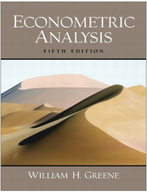Data on U.S. gasoline consumption for the years 1960 to 1995 are given in Table F2.2. a
Chapter 4, Problem 11(choose chapter or problem)
Data on U.S. gasoline consumption for the years 1960 to 1995 are given in Table F2.2. a. Compute the multiple regression of per capita consumption of gasoline, G/pop, on all the other explanatory variables, including the time trend, and report all results. Do the signs of the estimates agree with your expectations? b. Test the hypothesis that at least in regard to demand for gasoline, consumers do not differentiate between changes in the prices of new and used cars. c. Estimate the own price elasticity of demand, the income elasticity, and the crossprice elasticity with respect to changes in the price of public transportation. d. Reestimate the regression in logarithms so that the coefficients are direct estimates of the elasticities. (Do not use the log of the time trend.) How do your estimates compare with the results in the previous question? Which specification do you prefer? e. Notice that the price indices for the automobile market are normalized to 1967, whereas the aggregate price indices are anchored at 1982. Does this discrepancy affect the results? How? If you were to renormalize the indices so that they were all 1.000 in 1982, then how would your results change?
Unfortunately, we don't have that question answered yet. But you can get it answered in just 5 hours by Logging in or Becoming a subscriber.
Becoming a subscriber
Or look for another answer
